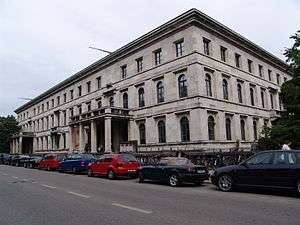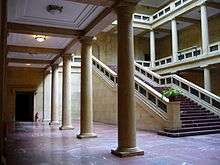Führerbau


The Führerbau - translated as "the Führer's building" - was built from 1933 to 1937 after the plans of architect Paul Ludwig Troost, at the address Arcisstrasse 12 in Maxvorstadt, Munich. The first plans were made in 1931. The building was completed three years after Troost's death by Leonhard Gall.
During the Nazi times, the building served as a representative building for Adolf Hitler. The Führerbau has historical significance for being the place where Neville Chamberlain and Adolf Hitler signed the Munich treaty in 1938. Architecturally speaking, the Brienner Strasse is a symmetry axis - at the Katharina-von-Bora-Strasse 10, a very similar building stands: The "Verwaltungsbau der NSDAP" (Administrative Building of the NSDAP). After the German surrender, the US occupation forces used both buildings as the "Zentrale Sammelstelle" (central collecting place) that cared for the looted pieces of art that were stolen by Nazis in the whole of Europe.
Today, the building houses the Hochschule für Musik und Theater München (University of Music and Performing Arts Munich). Its congress hall now serves as a concert venue.
- http://website.musikhochschule-muenchen.de/ Website of the Hochschule für Musik und Theater München
| Wikimedia Commons has media related to Führerbau. |
Coordinates: 48°08′46″N 11°34′04″E / 48.14611°N 11.56778°E